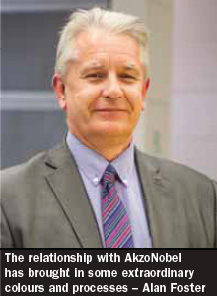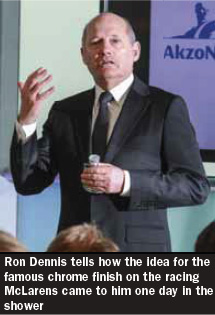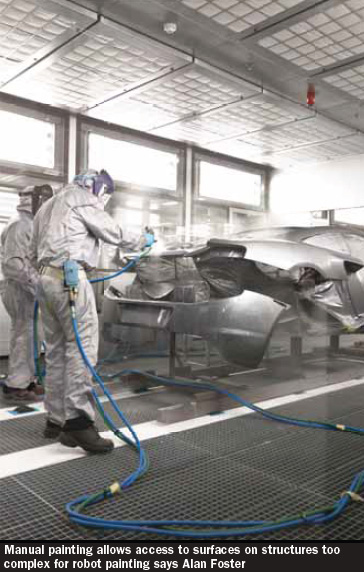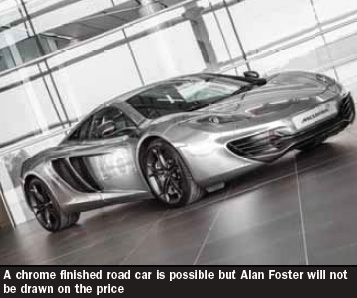
AkzoNobel won the contract to supply paint for McLaren road cars partly through its experience with the chrome finish on the carmaker’s Formula 1 cars, and also through its determination and innovation
McLaren has been working with AkzoNobel since 2008, first with its Vodafone McLaren Mercedes (VMM) Formula 1 team. APS visited the carmaker to see how this relationship has been expanded to include its exciting range of road cars and review the supplier's technology-led paint solutions for the MP4-12C and MP4-12C Spider, as well as the P1, when it enters production. And it is not just the paint technology that attracted Alan Foster, Operations Director at McLaren Automotive, to the AkzoNobel brand: “We were looking for more cultural synergies with our paint provider; we wanted to work with a company that has the same kind of cultural DNA as McLaren. When we went into production with the MP4-12C, we looked at five companies, and we did not start production with AkzoNobel. But I was very impressed with their determination; they very thoroughly analysed why they had not won the contract. They offered a more diverse approach than our first provider and worked extra hard to exceed our expectations.”
 An example of this imaginative approach is the use of low bake ovens; McLaren started developing its low bake (80°C) oven system when it was building the SLR with Mercedes- Benz, a strategy that is necessary for carbon and some composite structure painting and is also a lot less energyintensive. To achieve a high-quality and durable finish at these low temperatures seemed beyond the will of some material providers as Foster says: “Some companies turned away from this challenge and said to me that ‘no, this is too difficult.’ I would say that one of part the McLaren ethos is that no challenge is too difficult; have you got the willpower and determination to face the challenge? We have been delighted to find that AkzoNobel have got those qualities.”
An example of this imaginative approach is the use of low bake ovens; McLaren started developing its low bake (80°C) oven system when it was building the SLR with Mercedes- Benz, a strategy that is necessary for carbon and some composite structure painting and is also a lot less energyintensive. To achieve a high-quality and durable finish at these low temperatures seemed beyond the will of some material providers as Foster says: “Some companies turned away from this challenge and said to me that ‘no, this is too difficult.’ I would say that one of part the McLaren ethos is that no challenge is too difficult; have you got the willpower and determination to face the challenge? We have been delighted to find that AkzoNobel have got those qualities.”
Ron Dennis and the birth of the chrome racecar
The idea for the extraordinary ‘chrome’ paint on the McLaren F1 cars came about in Ron Dennis’ shower. He tells of how, as he finished showering one morning in 2007, he reached for a bottle of aftershave and noticed the plastic cap finished in chrome. He reasoned that while this chrome finish is usually made by electroplating, if a small plastic part like a perfume bottle top could be finished in chrome, why not a racing car?
Dennis decided to find out if this was possible and he and his team searched the world for a durable high quality chrome  paint. They found several suppliers, who were more used to providing the finish for the custom car market. But the paint was difficult to apply and to achieve the right level of reflectance, the coating was extremely heavy, in GP car terms. At this time, Dennis hadn’t yet selected a coatings provider, but did have a good idea of what AkzoNobel was capable of, because its Aerospace Coatings unit had provided the paint for his private jet. First, AkzoNobel had to demonstrate that it could produce a super-lightweight VOC compliant system in McLaren’s striking chrome and red colours for the MP4-24 carbon fibre substrate. And then, when AkzoNobel got the go-ahead as the new coatings provider to McLaren’s F1 team, it had to deliver on an extremely tight schedule in order to get the car ready for the 2009 racing season.
paint. They found several suppliers, who were more used to providing the finish for the custom car market. But the paint was difficult to apply and to achieve the right level of reflectance, the coating was extremely heavy, in GP car terms. At this time, Dennis hadn’t yet selected a coatings provider, but did have a good idea of what AkzoNobel was capable of, because its Aerospace Coatings unit had provided the paint for his private jet. First, AkzoNobel had to demonstrate that it could produce a super-lightweight VOC compliant system in McLaren’s striking chrome and red colours for the MP4-24 carbon fibre substrate. And then, when AkzoNobel got the go-ahead as the new coatings provider to McLaren’s F1 team, it had to deliver on an extremely tight schedule in order to get the car ready for the 2009 racing season.
An extra benefit of the chrome paint finish on the GP cars was to ‘trick’ the lenses of the television cameras to open more than with plain finishes and so McLaren’s F1 cars effectively received more attention.
Production paint for road supercars
As McLaren has ramped up its road car programme, under Ron Dennis’ management, so some very special finishes were called for as he explains: “Now the relationship with AkzoNobel has embraced all of McLaren production cars with some extraordinary colours and processes that not only protect the car and give it a consistency of colour, but also to innovate a range of ‘volcanic’ colours, with a similar weight saving element to the race car coatings.”
The road cars, as with the F1 cars, are made from as many as four different materials, from aluminium to complex composites and these surfaces put a tremendous demands on the adhesion qualities, opacity and durability of any coating, as Dennis says: “The technical challenge of getting a consistent colour and density on our cars is much more difficult than on a car made of aluminium or steel.”
 The structure of the 12C road car consists of a carbon fibre ‘monocell’ with aluminium front and rear crash structures, the rear end of the car is made from a sheet moulded compound (SMC) in a very lightweight ‘crashable’ plastic material. The roof section and front fenders are aluminium (for pedestrian safety), and the front and rear bumpers are moulded from polyurethane. This mixed composite construction creates some challenges to achieve good paint adhesion as Alan Foster says: “The front end is electrocoated which we then paint here with a primer surfacer, the SMC is in-mould coated, again we add primer surfacer to this, to provide a good base for the colour and clear coats.”
The structure of the 12C road car consists of a carbon fibre ‘monocell’ with aluminium front and rear crash structures, the rear end of the car is made from a sheet moulded compound (SMC) in a very lightweight ‘crashable’ plastic material. The roof section and front fenders are aluminium (for pedestrian safety), and the front and rear bumpers are moulded from polyurethane. This mixed composite construction creates some challenges to achieve good paint adhesion as Alan Foster says: “The front end is electrocoated which we then paint here with a primer surfacer, the SMC is in-mould coated, again we add primer surfacer to this, to provide a good base for the colour and clear coats.”
Clean and open paintshop design
The paintshop at McLaren has a distinct visual ‘openness’ that the whole assembly facility features; the paint equipment supplier Eisenmann at first showed Foster a polishing booth simulation, with windows all round; the kind of visibility that he wanted. They then showed him the plan for the painting booths, with steel walls and small windows into the work cells, he asked: “Why can’t I have glass walls everywhere?” The Eisenmann engineers wondered why; “It is quite simple, I want to be able to stand in one point in the plant and see everything, everywhere, as I can with assembly etc. They took that on and it was not actually much more expensive to have glass walls instead of steel,” he says.
 “Of course we have the challenge of keeping the glass clean; the ventilation panels in the roof, which blow vented circulated air, provide a ‘jet stream’ that runs across the booth and provides an air curtain to the inside of the glass, keeping them clean and clear. We need to clean the windows only once a week.” This creates what is effectively a clean room, with the cars painted in what McLaren calls pairs – one skid carries doors, lower quarter panels, tonneau panels and small hang-on parts; a second skid carries the main body, fenders and front bumper. This allows one complete vehicle to be painted at once, using the same personnel and the same ‘lot’ of paint, ensuring colour and finish consistency. This is particularly important with the complex colour and effect paints used.
“Of course we have the challenge of keeping the glass clean; the ventilation panels in the roof, which blow vented circulated air, provide a ‘jet stream’ that runs across the booth and provides an air curtain to the inside of the glass, keeping them clean and clear. We need to clean the windows only once a week.” This creates what is effectively a clean room, with the cars painted in what McLaren calls pairs – one skid carries doors, lower quarter panels, tonneau panels and small hang-on parts; a second skid carries the main body, fenders and front bumper. This allows one complete vehicle to be painted at once, using the same personnel and the same ‘lot’ of paint, ensuring colour and finish consistency. This is particularly important with the complex colour and effect paints used.
Air curtain technology also allows rapid transition from colour to colour without any risk of residual overspray contamination from the previous spraying, particularly important as all the finish is applied with pneumatic sprayguns. While every vehicle is considered bespoke, Foster says ‘clustering’ of colours is used to speed the process: “We load cars in customer order sequence, and then try and cluster as many of the same colour cars before the bodies go into the paintshop, paint them and then re-sequence the cars back into customer order.”
With the small range of vehicle types being painted, the paintshop would seem an ideal candidate for some automation. Foster has planned for this possibility: “At some point we may go to robot application; I have an empty booth, pre-configured with all the infrastructure for robots but at the moment, with the volumes we are painting, it doesn’t make financial sense.” The team of sprayers in the plant have been with McLaren since 2005 and Foster is very pleased with them: “The lads have been with me for a long time and they give me tremendous flexibility and consistency, and the ability to paint structures too complex for most conventional robot programmes. For example, the doors are dihedral and thus have faces that would not be seen on a conventional car and it would be very difficult for a robot to ‘get in there’.”
Partnering for optimum colour consistency
The exotic finishes offered on the 12C and the P1 cars demand a lot of colour palette ‘maintenance’ to achieve the finish Foster’s customers expect: “We have been working closely with AkzoNobel on our paint systems to get better colour consistency, so that we don’t get any ‘drop’ or shade changes of finish. Some of the finishes are unique, with a high density and opacity of a complex colour. “We do struggle a little with the opacity of some colours, particularly the blues and oranges, used to require more passes but Akzo have made some improvements to the chemistry that have helped to cure this.” Paint handling is carried out in a mixing room below the paintshop, where basecoat is mixed and delivered in a potbased colour change system. Choosing the quantities is easier than one might expect, as Foster says: “What we have found is that in the 17 colour palette, have about the same demand for all the colours, including white. Some of the colours are made in small volume pots, but most are mixed in larger quantities, enough for runs of five to ten cars.”
Foster’s customers expect: “We have been working closely with AkzoNobel on our paint systems to get better colour consistency, so that we don’t get any ‘drop’ or shade changes of finish. Some of the finishes are unique, with a high density and opacity of a complex colour. “We do struggle a little with the opacity of some colours, particularly the blues and oranges, used to require more passes but Akzo have made some improvements to the chemistry that have helped to cure this.” Paint handling is carried out in a mixing room below the paintshop, where basecoat is mixed and delivered in a potbased colour change system. Choosing the quantities is easier than one might expect, as Foster says: “What we have found is that in the 17 colour palette, have about the same demand for all the colours, including white. Some of the colours are made in small volume pots, but most are mixed in larger quantities, enough for runs of five to ten cars.”
With the P1 supercar coming into production soon, with its total carbon fibre substrate, I asked Foster what he had planned to accommodate this material change: “The quality of the surface will be ‘levelled up’ a lot more, we will use a high build primer and this is partly why P1 will not go through this paintshop, plus P1 is offered with up to five different colours on each car.”
Colours such as Volcano Red and Volcano Orange (developed to closely match the colour of the last McLaren F1 built) demand a great deal of care in mixing and application and this is where the partnership with AkzoNobel is so effective, as Foster says; “The Volcano red for example, has a basecoat that appears almost a satin finish, when we apply the effect clearcoat, we get a deep, almost rusty red colour.
“Akzo have also helped us develop the yellow that we launched on the 12C Spider, this has a very fine green tint in it [created by using green spheres in the mix, not a flake or pin particle]. They have also worked with us over the last year, developing colour consistency on one of our very popular colours, the historic very deep ‘Can-Am’ orange.”
Advanced booth design and low bake ovens
The spraying booths use electro-plate technology; with no water ‘flume’ under the floor grids but an electric field that recovers overspray. Paint is baked for 54 minutes at 80°C to protect the carbon fibre structure and this means that air conditioning is not necessary anywhere in the plant, as Foster says: “We use only an air change system; this means that ecologically, environmentally, the plant is very green and the design saves us a lot of money on the lower oven heat alone. And we do not have a water treatment plant to worry about, with its associated chemicals and possible hazardous waste.” I asked Foster how he achieved a really hard and fine finish at 80°C: “We get the great finish mainly through the advanced paint chemistry; this is based around aftermarket refinishing technology, and is all water borne except for the clearcoat, we work to about 100 micron total coating thickness, and this gives us plenty of material for polishing.”
McLaren are working with AkzoNobel on a new painting technology which Foster says will improve transfer efficiency by up to 30%, and the paint supplier is working with McLaren to improve colour fastness, and hardness of the clearcoat to guarantee longevity of finish.
At one side of the paintshop there are two comfortable lounge chairs, where customers often come and sit, with a McLaren sales person, to watch their car being painted. The painting process at McLaren has moved on significantly since the days of the F1; in the ‘old’ paintshop, now used exclusively by the GP team, the highest output was three cars per day. Now, as Foster says: “We know we were going to have to paint 20 cars per day and so it dictated the layout of the whole production centre – we built the facility around the paintshop.”
Chrome paint on road cars
As one might imagine, some McLaren customers would like their 12C, or even P1 in the future, to be finished in chrome as per the GP cars. But, as Alan Foster says: “I do get asked if we can do that finish on the road cars; it is legal and possible but it would be very expensive. I can’t give an exact price but let me just say that anything that costs more than £10,000, I consider to be very expensive!”




































